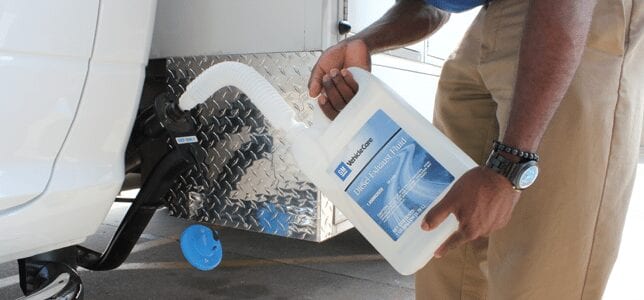
What is DEF?
Diesel Exhaust Fluid (DEF) is a chemical compound that combines high purity urea with deionized water. DEF is basically an industry term for aqueous urea. Some prefer the term “DEF” because urea sounds like a different type of fluid — the stinky kind. Diesel exhaust fluid, however, is odorless and colorless. It’s used in Selective Catalytic Reduction (SCR) to help lower diesel exhaust emissions.
How DEF Works
Diesel engines create soot during the combustion process. Soot is a harmful air pollutant, so modern diesels are designed to run lean. This gives them a high air-to-fuel ratio. The excess oxygen creates more heat, which burns the soot. But it also combines with nitrogen in the exhaust stream to create nitrogen oxides.
Nitrogen oxides are harmful air pollutants.
This is where the aforementioned selective catalytic reduction comes into play. SCR is a process that uses DEF to reduce emissions by cutting down on the amount of nitrogen oxides released into the air.
Got all that? Good. This is where it gets interesting.
In January 2010, the Environmental Protection Agency (EPA) introduced a DEF requirement for most diesel vehicles. Consequently, several engine manufacturers adopted selective catalytic reduction technology, which uses DEF to convert toxic nitrogen oxides into harmless nitrogen gas.
What Happens if the DEF Runs Out?
Diesel exhaust fluid is stored in a special tank on board the chassis. Having an appropriate supply reduces emissions and extends refill intervals. It should be extremely difficult to run out of DEF, given the ample warning strategies utilized in a modern fleet.
Most vehicles will show several warnings to signal a low DEF tank. If the messages are ignored, a speed restriction protocol kicks in. This speed limit can vary from chassis to chassis.
In a Chrysler product, such as a Dodge Ram, the speed drops to 5 MPH. A Chevrolet vehicle will be limited to 55 MPH at first and ultimately to 4 MPH. Ford will be reduced to 50 MPH, but tampering with or disabling the exhaust system will cause the speed to dip to 5 MPH.
| Chassis | Warning Signal / Range | Speed Limit |
|---|---|---|
| Ford | A message is displayed in the message center when DEF level is low. | 50 MPH and, ultimately, 5 MPH |
| Chevrolet | Warnings at 1000 and 300 mile range | 55 MPH and, ultimately, 4 MPH |
| Dodge Ram | Warning at 200 mile range | 5 MPH on restart, long idle, or refuel |
| Freightliner | DEF warning bar illuminates amber when DEF tank is very low | 5 MPH on restart |
Regardless of the chassis, an empty DEF tank can activate the service mode and slow you down. So you should always maintain a proper DEF level in your vehicle. If you do happen to run out of DEF while driving a Frazer, the good news is that you’ll still have access to independent, unrestrained generator power. With a Frazer, you’ll still be able to run your emergency systems, radios, and ultra-cool air conditioner, while you wait for backup. Plus, you can always carry two or three gallons of DEF in one of our numerous exterior storage compartments.
There’s no guessing game when it comes to maintaining a proper DEF level. Check your fluids regularly, pay attention to the warning messages, and always maintain a full tank of DEF.
Any questions? Give us a call or send us a message on Facebook.

